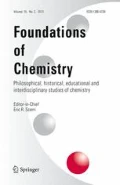-
1.
The Disappearing Spoon is not a book about the detailed chemistry of the chemical elements nor does it describe the development of the periodic system. It is a collection of anecdotes about people and happenings, each tale linked to one element of the periodic table.
-
2.
The stories are grouped together in chapters with a common theme, e.g., Chapter 9, “Poisoner’s Corridor”, features elements: cadmium, thallium, bismuth, thorium and americium. Topics in the chapters range from the attitude of Gandhi toward salt, to the Big Bang Creation of the Universe. In Chapter 10, we learn how Oliver Sacks successfully treated patients suffering from Parkinson’s disease with L-dopa. In Chapter 11, we learn how dangerous the inert gas nitrogen can be. Breathing an atmosphere of this pure gas killed NASA technicians who were working on the space ship Columbia.
-
3.
The reader will find everything of interest in this book. There is something here for everyone: students, teachers, businessmen and -women. Every school library should have a copy. You don’t have to be scientist to be fascinated by the contents.
-
4.
At the end of the book, there is a valuable collection of notes which amplifies sections of the text. There is also a bibliography, an index and a periodic table.
-
5.
I enjoyed reading this book. I strongly recommend it.
-
6.
And the “disappearing spoon”? This refers to the mysterious element gallium, a metal that will melt in your hand. Read all about it in this book.
Author information
Authors and Affiliations
Corresponding author
Rights and permissions
About this article
Cite this article
Laing, M. Sam Kean: The disappearing spoon: and other true tales of madness, love, and the history of the world from the periodic table of the elements. Found Chem 13, 77 (2011). https://doi.org/10.1007/s10698-010-9101-x
Published:
Issue Date:
DOI: https://doi.org/10.1007/s10698-010-9101-x

